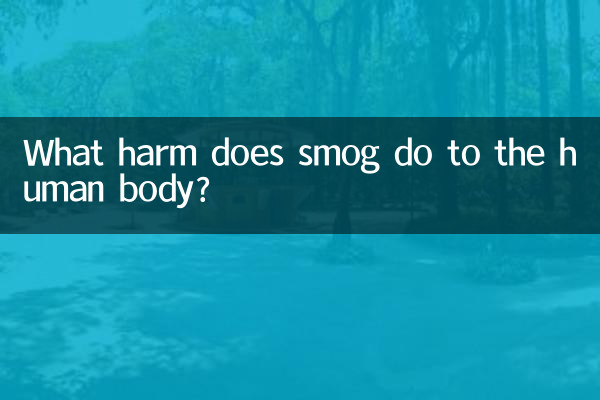What harm does smog do to the human body?
In recent years, the haze problem has become increasingly serious and has become the focus of global attention. Smog not only affects air quality, but also causes many harms to human health. This article will combine the hot topics and hot content on the Internet in the past 10 days to analyze the harm of smog to the human body in detail, and provide structured data for reference.
1. Main components of smog and its harm

Smog is mainly composed of the following harmful substances, and the harm of these substances to human health cannot be ignored:
| Ingredients | primary source | Harmful to human body |
|---|---|---|
| PM2.5 | Industrial emissions, automobile exhaust | Cause respiratory disease, cardiovascular disease |
| PM10 | Construction dust, road dust | Irritate the respiratory tract and induce asthma |
| Sulfur dioxide (SO2) | Coal burning, industrial waste gas | Cause bronchitis, emphysema |
| Nitrogen oxides (NOx) | Vehicle exhaust, industrial emissions | Damages lung tissue and increases cancer risk |
| Ozone (O3) | photochemical reaction | Irritate eyes and respiratory tract, reduce immunity |
2. The direct impact of smog on human health
The harm of smog to human health is multifaceted. The following are its main effects:
1. Respiratory diseases
Particulate matter and harmful gases in smog can directly enter the respiratory tract, causing symptoms such as cough, sore throat, and bronchitis. Long-term exposure to smog may also increase the risk of lung cancer.
2. Cardiovascular disease
Fine particulate matter such as PM2.5 can enter the blood circulation through the alveoli, causing vasoconstriction, raising blood pressure, and increasing the risk of myocardial infarction and stroke.
3. Damage to the immune system
Harmful substances in smog can weaken human immunity and make people more susceptible to viruses and bacteria, especially children and the elderly.
4. Skin problems
Pollutants in haze will adhere to the skin, causing skin allergies, dryness, accelerated aging and other problems.
3. The harm of haze to special groups of people
Certain groups of people are more sensitive to smog and the harm is more serious:
| crowd | Main hazards |
|---|---|
| children | Affects lung development and increases asthma risk |
| elderly | Aggravate chronic diseases and increase mortality |
| pregnant woman | Affect fetal development and increase the risk of premature birth |
| Chronic disease patients | Aggravate the condition and increase the risk of complications |
4. How to reduce the harm of haze to human body
In the face of smog, we can take the following measures to reduce its harm to the human body:
1. Reduce going out
When haze is severe, outdoor activities should be reduced as much as possible, especially for children and the elderly.
2. Wear a mask
Choose anti-haze masks that meet standards, such as N95 masks, which can effectively filter particles in the air.
3. Use an air purifier
Using an air purifier indoors can effectively reduce indoor PM2.5 concentration.
4. Dietary conditioning
Eat more foods rich in vitamins C and E, such as fruits and vegetables, to enhance immunity.
5. Pay attention to air quality
Pay attention to the Air Quality Index (AQI) in real time and arrange your travel plans appropriately.
5. Conclusion
Smog has many harmful effects on human health, especially the damage to the respiratory system, cardiovascular system and immune system. Special groups such as children, the elderly and pregnant women need more protection. By taking scientific protective measures, we can effectively reduce the harm of haze to the human body. I hope this article can help everyone better understand the dangers of smog and take proactive measures to deal with it.

check the details

check the details